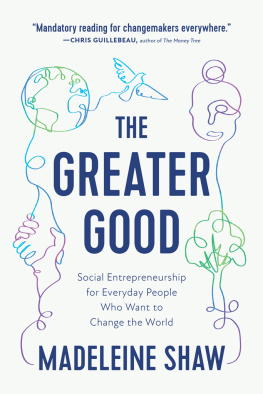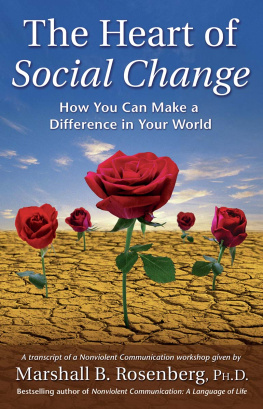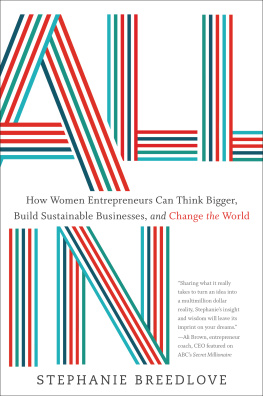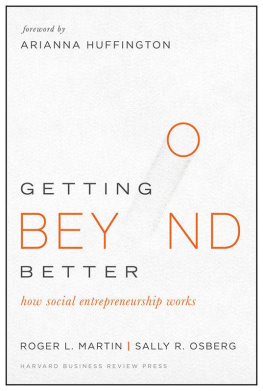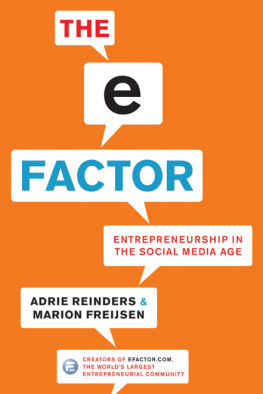How to Change the World
Also by David Bornstein:
The Price of a Dream: The Story of the Grameen Bank
How to Change the World
David Bornstein


Oxford University Press, Inc., publishes works that further
Oxford Universitys objective of excellence
in research, scholarship, and education.
Oxford New York
Auckland Cape Town Dar es Salaam Hong Kong Karachi
Kuala Lumpur Madrid Melbourne Mexico City Nairobi
New Delhi Shanghai Taipei Toronto
With offices in
Argentina Austria Brazil Chile Czech Republic France Greece
Guatemala Hungary Italy Japan Poland Portugal Singapore
South Korea Switzerland Thailand Turkey Ukraine Vietnam
Copyright 2007 by David Bornstein
Published by Oxford University Press, Inc.
198 Madison Avenue, New York, New York 10016
www.oup.com
Oxford is a registered trademark of Oxford University Press
All rights reserved. No part of this publication may be reproduced,
stored in a retrieval system, or transmitted, in any form or by any means,
electronic, mechanical, photocopying, recording, or otherwise,
without the prior permission of Oxford University Press.
Bornstein, David.
How to change the world: social entrepreneurs and the power of new ideas /
David Bornstein.
p. cm.
Includes bibliographical references and index.
ISBN 978-0-19-533476-0 (pbk.)
1. Social actionCase studies. 2. Social serviceCase studies.
3. Social reformersCase studies. I. Title.
HN18.B6363 2007
361.2dc22 2007022907
The photos on pages 24, 86, 131, 207, and 209 were taken by David Bornstein. The author wishes to thank the following organizations and individuals for permission to use the photographs and images appearing on the following pages: Childline (Credit: Ruhani Kaur) (71, 80); College Summit (174, 182); Bill Drayon (17, 18, 56); Doones-bury 1982 G. B. Trudeau. Reprinted with permission of UNIVERSAL PRESS SYNDICATE. All rights reserved (60); Thys Dullaart (189, 204); Janet Jarman ( www.janet jarman.com ) (103, 104, 108, 116, 159); UCPEDP (221, 225, 233); Skye Raiser ( www.skyephotography.com ) (175); Renascer (134, 138); Fbia Rosa (34); J. B. Schramm (165); UNICEF (UNICEF/HQ 931144/John Isaac) (248); UNICEF/BAWG 90281/Ellan Young (255); UNICEF/HQ 850005/Balazar (258); Verve Magazine (Credit: Deepa Prekh) (76).
The Polar-area diagram appearing on page 46 comes from Florence Nightingales book Notes on Matters Affecting the Health, Efficiency and Hospital Administration of the British Army (1858).
The jacket photos are courtesy of (from left to right): UNICEF (Rwanda/Press), NCPEDP, Bill Drayton, and Verve Magazine (Deepa Pareck). The background image of hills was created by Diana Todd.
1 3 5 7 9 8 6 4 2
Printed in the United States of America
on acid-free paper
For Abigail,
who thrills me still
Preface
Is it possible to eradicate poverty? Extend health care to every corner of the world? Ensure that every child in every country receives a good education? These visions may seem beyond reach today, but the stories in this book reveal that we can, in fact, change the world in ways that seem unbelievable. There is a hidden history unfolding today: an emerging landscape of innovators advancing solutions that have the potential to transform life around the globe.
We hear little about them. Indeed, most of the news we receive focuses on the troubles in the world. Clearly, we face a cascade of challenges and dangers at home and abroadand we need to know about them. But while we are inundated with stories of violence, corruption and incompetence we hear relatively little about the struggles and successes of the people who are advancing positive changes. The ratio of problem-focused information to solution-focused information in the media is completely out of balance. It distorts reality; it is dispiriting; and it deprives people of the knowledge they need to properly assess risks and recognize opportunities. If you were asked to list ten problems facing the world, how long would it take? Two minutes? How long would it take you to list ten solutions?
This book tells the stories of social entrepreneurs advancing systemic solutions to major social problems. Since 2004, when the first edition of this book was published, the field of social entrepreneurship has grown and attracted new levels of interest. The use of the term social entrepreneur in the media has roughly tripled. Ashoka, the international network of social entrepreneurs whose work is chronicled in these pages, has extended its reach into twenty new countries across Western Europe and the Middle East, as well as Turkey, Morocco, Afghanistan and The Philippines. The organization recently elected its first fellow in Saudi Arabia, a woman, and is now searching for social entrepreneurs in Israel and recruiting representatives in China and Japan. By the end of 2007, Ashoka will have directly supported 2,000 social entrepreneurs who are working in close to 70 countries. (See the afterword for detailed updates about the specific organizations highlighted in the book.)
Significantly, in two of the past three years, the Nobel Peace Prizes were awarded to social entrepreneurs: Wangari Maathai, founder of the Green Belt Movement, in 2004, and Muhammad Yunus and the Grameen Bank in 2006. This may represent a shift in focus for an honor that has historically focused on the political arena. In a speech at the Global Philanthropy Forum in 2007, Bill Clinton said that he looked forward to the day when Bill Drayton, the founder of Ashoka, whose story is detailed in this book, would receive the Nobel Peace Prize.
Across the worldfrom the Said Business School at Oxford University, to the IESE Business School of the University of Navarra in Spain, to the Tata Institute of Social Sciences in India, to the Fundaco Getulia Vargas in Brazil, to the Gordon Institute of Business Science at the University of Pretoria in South Africauniversities are studying social entrepreneurship in increasing numbers. In the United States and Canada alone, more than two hundred universities have established centers, courses, competitions, scholarships or speaker series focusing on this field. One of the most interesting initiatives is the Reynolds Program in Social Entrepreneurship housed at New York Universitys Robert F. Wagner Graduate School of Public Service, which draws its fellows from the entire university, including the schools of education, dentistry, law and medicine, thus demonstrating that there is a changemaker path for every student whatever their specialty or major.
Everywhere you look, conceptual firewalls that once divided the world into social and economic realms are coming down and people are engaging the world with their whole brains. When Larry Page and Sergey Brin established Google.org, the philanthropic arm of Google, they set it up as a for-profit firm so it could make grants or investments and also lobby the government. (In the future, there will likely be new legal designations for such social-benefit hybrid firms.) The Omidyar Network, established by eBays founder Pierre Omidyar and his wife, Pam, has invested some $90 million in businesses and nonprofit organizations in an effort to nurture environments that unleash peoples potential. The Acumen Fund, a nonprofit global venture fund, has raised more than $40 million to make investments in companies that extend access to clean water, health products, and housing at affordable prices to people in underserved markets. Similarly, Ashoka, which has invested $145 million to identify and support social entrepreneurs, is now advancing a framework by which its fellows can join forces with large corporations to create businesses that provide vital products and services to large groups of people whose needs are unmet. From a different angle, Jeff Skoll, the first President of eBay, has created a foundation and a for-profit film company that reinforce each others efforts. While the Skoll Foundation has provided $55 million to support social entrepreneurs, Participant Productions has developed an array of mainstream films that build public awareness about the same issues that social entrepreneurs focus onsuch as environmental protection (An Inconvenient Truth), economic inequality and health (Fast Food Nation) and cross-cultural understanding (The World According to Sesame Street).
Next page

